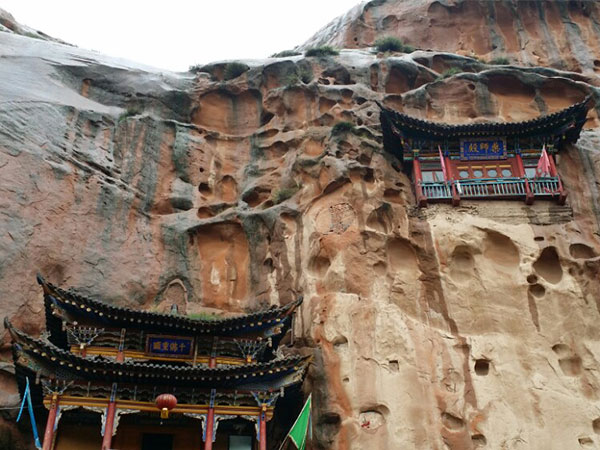Mati Temple Grottoes(Chinese name: 马蹄寺石窟) is one of the important Buddha grottoes in China. Located in Linsong Mountain which is about 80 km away from the South Yugur Minority Autonomous County of Gansu Province. The grottoes can be divided into north temple, south temple, thousand buddha cave, golden pagoda temple, upper/middle/lower Avalokitesvara caves etc.. Each part is away from another one less then 10km. Because the mountain was formed by coarse red sandstone which was not suitable for carving, most of the grottoes are clay sculptures.
History
No an official record says when did Mati Temple build. According to a history material which is dated back to Eastern Jin Dynasty, a traveler family name Guo in that period described a grottoes in his travelogue “ Travel to Zhengye, and then live in Linsong Valley, and chisel a cave to dwell” Another record continue to describe the grottoes as following “After Guo chiseled the cave, posterity continued to enlarge it and then create buddha sculptures inside.”.
From the shape of the grottoes and the style of the buddha sculptures, some parts in Golden Pagoda Temple, North Temple, and Thousand Cave were built between 5th and 6th centuries. And some others may be built in early 5th century or even earlier than that. So generally, Mati Temple may be deeply related with the “South Mountain Grottoes of Liang Country” which was created by Ju Qu Meng Xun, the king of North Liang Country. Moreover, most caves were rebuilt or renovated between Northern Wei and Ming Qing dynasties.
Grottoes in Each Part
The most well-preserved part will be in Golden Pagoda Temple. The caves are excavated on a 60-meter-high precipice which is about 15km from Mati Temple. There are two existing pagoda-shape central supporting cave.
Northern Dynasty grottoes are mostly in Thousand Buddha Cave. Located on the northwest side of Mati Temple, there are more than 10 grottoes. No. 2 and No. 8 caves are pagoda-shape central supporting cave, preserved sculptures and frescos of Northern Wei and Northern Zhou dynasties.
There are more than 30 grottoes in Northern Temple of Mati Mountain. Most of the grottoes were created in Northern, Western Xia, Yuan, and Ming dynasties. The No. 8 cave is the largest scale Buddhist palace with a depth of 33.5 meters and a width of 26.3 meters. It was built around Western Xia dynasty.
From the artistic values, the most precious ones are in Golden Pagoda Temple. With many times renovation, the sculptures inside it is still kept the original appearance. The rich expressions on sculptures’ faces, the elaborate decorations on the sculptures’ bodies, the Flying Apsaras art, all of these show the high triumphs of China early phase grottoes.
Significance
Mati Temple Grottoes includes Thousand Buddha Cave, Northern and Southern Mati Temple, Upper/Middle/Lower Avalokitesvara caves, and Golden Pagoda Temple 7 cave groups, totally more than 70 caves. Because of the long history of Mati Temple Grottoes, it ranks of one of the top three Hexi Buddhism culture grottoes in China, with the valuable position of Mogao Grottoes in Dunhuang and Yulin Grottoes in Anxi.

